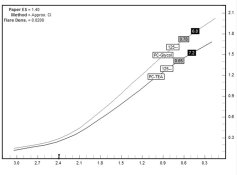pauldc said:
1. Since the thread was written how are people getting on with this non-TEA PC developer? I am particularly interested in using it with FP4+ as I have heard that it is the closest thing to my dearly departed Paterson Acutol!
I've never used Acutol, so I can't comment on results from Gainer's developers compared to it. I can say this, though: Just a couple of hours ago I processed a roll of Fomapan 200 in PC-Glycol (as described in Gainer's PT article) 1+1+48. I mixed it originally in May of 2005, so it's over a year old, and it's still working fine. I used Dimezone S rather than phenidone in mine, though, and that could improve the longevity of the solution. I've used PC-Glycol with several films, including Fomapan 200, Fomapan 400, Ilford Pan F+, and Svema FN64, and it's worked well with all of them.
pauldc said:
2. I am confused by the seemingly different ratios of Phenidone and Vit C in the non TEA recipe to the original TEA recipe.
The formulas I've got are:
PC-Glycol:
Stock "A":
ascorbic acid: 10g
phenidone: 0.25g
propylene glycol to make: 100ml
Stock "B":
sodium carbonate, anhydrous: 15g
water to make: 100ml
Use 1+1+48; developing times roughly 10% greater than XTOL 1+1 times (based on personal experience). You can experiment with the stock "B" solution (use borax, for instance), if you like.
PC-TEA:
triethanolamine, 99%: 100ml
ascorbic acid: 9g
phenidone: 0.25g
water to make: 0.1l
Use 1+50. I have no developing time data handy (I've never used it).
In terms of the ascorbic acid/phenidone ratios, they're similar, but not identical (10:0.25 for PC-Glycol and 9:0.25 for PC-TEA). I've seen the formulas on some Web sites (such as
this one) with slightly different numbers. Mine are from the original article (unless I erred in copying them, which is always possible). I believe Pat Gainer has done some tests on the optimum ratio of ascorbic acid to phenidone, but I don't recall the results.




 and I thought we were not supposed to work on Sundays.
and I thought we were not supposed to work on Sundays.